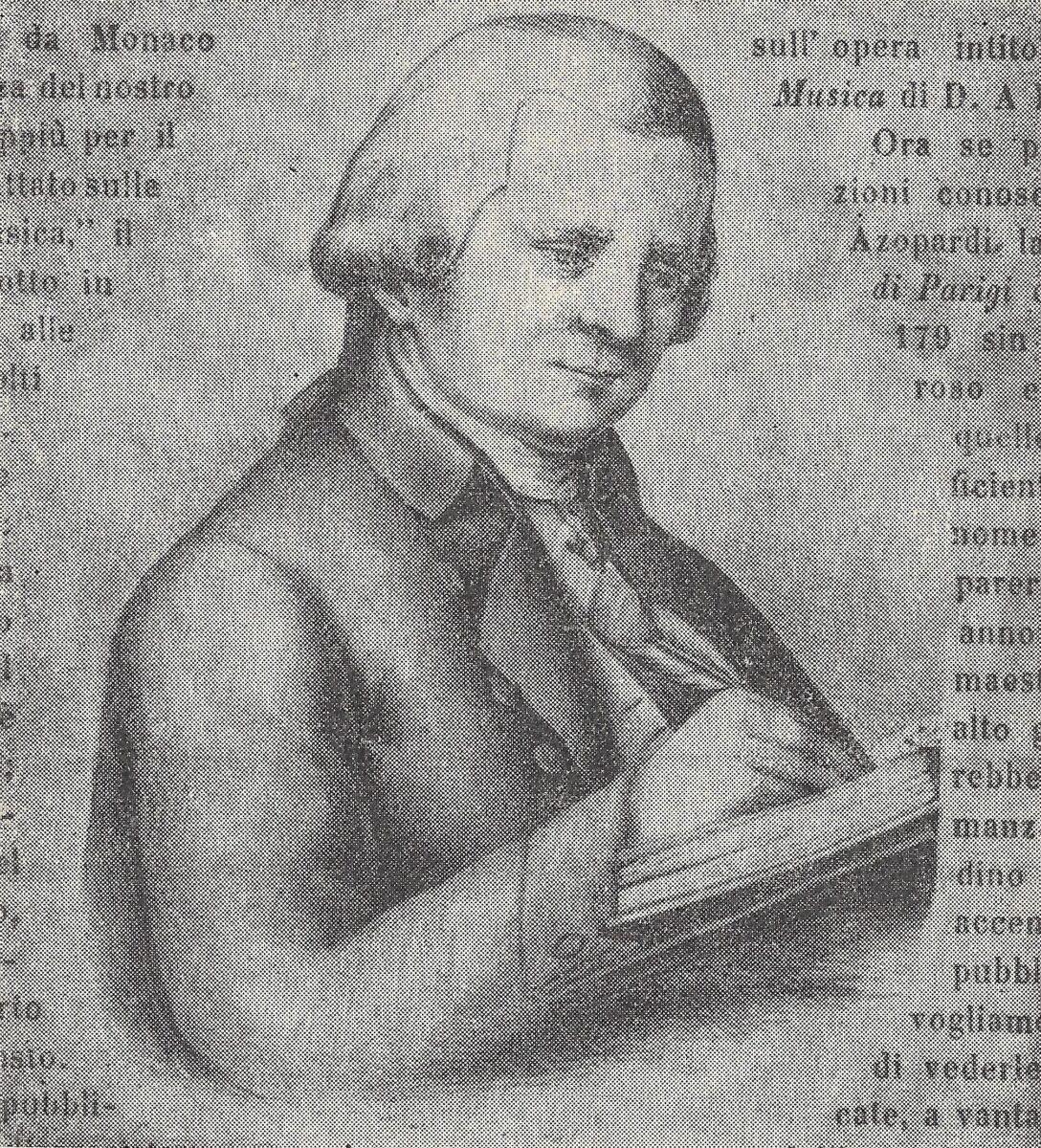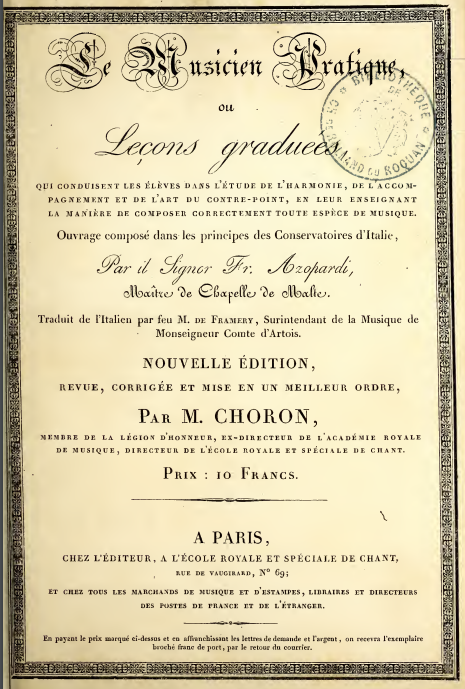Francesco Azopardi (1748 – 1809)


Born at Rabat, Azopardi, the second of six siblings is considered as one of the most important Maltese musicians of the 18th century. He was the son of Salvatore Azopardi, a carpenter and his wife Anna.
At the age of eight he received the clerical tonsure that signified that he was now a cleric under the jurisdiction of the Bishop. He had no intension of embracing the priesthood. As a chorister at St Paul’s Grotto and the church of St Publius in Rabat, Azopardi received his first training in Gregorian chant from the collegiate’s maestro di canto fermo, Rev Giovanni Battista Zerafa, brother of Benigno Zerafa. In 1761, after seven years of service, Azopardi terminated his church duties in order to concentrate on his musical studies. It was probably during the time that he became a student of Rev Michelangelo Vella at his school in Senglea.
After early studies with Rev Michelangelo Vella, he entered the Conservatorio Sant’Onofrio a Capuana on 15 October 1763 on his own initiative and at his parents’ expenses, and was taught, among others, by Carlo Contumacci and Giuseppe Doll. He left the conservatory in 1767 but remained in Naples to work as maestro di cappella and to continue his studies with Niccolò Piccinini, perhaps the leading Neapolitan composer of the time. Piccinini sent letters to Francesco by means of which he clearly expressed the noble esteem with which he held him. In 1768 Azopardi embarked upon his career as a composer with his first liturgical composition, the Mass in F (Mus.Ms. 339). A second Mass in G (Mus.M.369), appeared two years later in 1770. In addition to masses, Azopardi composed psalms and a Magnificat, which he himself conducted in Naples and on different occasions.
Whilst living in Naples, Azopardi visited his homeland several times, and he seems to have made all possible attempts to integrate himself with the Cathedral Chapter. During one of these visits, in 1772, the Chapter invited him to perform his new Messa di Gloria and his psalm Dixit Dominus, during the solemn liturgy of the commemoration of Saint Paul the Apostle celebrated annually on 30 June. Later Azopardi donated the autograph manuscript of both works to the Chapter.
On 12 April 1774, he accepted the position of organist for the Mdina cathedral and, following Benigno Zerafa’s resignation on 7 January 1787, he became the cathedral’s maestro di cappella. After the expulsion of the Order of St John from Malta, Azopardi was also appointed maestro di cappella of St John’s in Valletta. He held both positions until his death.
Azopardi was a person of rigorous habits, of deep religious conviction, reserved, and with very few friends. He never married and was looked after by his unmarried younger sister, Teresa. His interest was only music and he devoted his life to the four main responsibilities of a working maestro di cappella: composing, managing and rehearsing the cappella, conducting it during the designated sacred rites, and teaching. A much sought-after teacher, Azopardi taught composers like Pietro Paolo Bugeja, Nicolò Isouard, Giuseppe Burlon, Giuseppe Principato, Teodoro Piscopo, Marianna Schembri – a fine pianist – and many others. It was Azopardi’s growing interest in pedagogy that led him to write Il Musico Prattico, a practical guide ‘to the art of the counterpoint which will teach the student how to compose correctly various types of counterpoint’. As Azopardi points out in the introduction, he felt the need to write it because he was of the opinion that the existing manuals were too theoretical and lacked the practical instructions that would show a student how to use counterpoint based on the traditional Italian principles of basso continuo. His Il Musico Prattico, on the art of the counterpoint, which he wrote in Italian, subseqently was translated into French. This was published in Paris, first by Nicolas Etienne Framery (1786) and then in a revised edition by Alexander Choron (1816). Its admirers included Luigi Cherubini who called it ‘the catechism of every musician’. A later expanded version did not enjoy the original success. Il Musico Prattico remains the only treatise on music written by a Maltese, which attracted significantly international interest. Twenty years later, Azopardi revised and expanded his work, resulting in a work twice as long, containing in it 4 volumes of pedagogical work that was more refined, more demanding, and more complex.
In 1791 Azopardi composed the one-act La magica lanterna his only opera buffa. Then in 1792 he composed 2 settings of the Requiem Mass, the first on the occasion of the death of the Holy Roman Emperor, Leopold II; in 1793 he composed a setting of the Corpus Christi sequence Lauda Sion; c. 1795 Azopardi composed his Sinfonia (da Chiesa); and in 1802 he composed the oratorio La passione di Cristo to a text by Metastasio.
Azopardi loved to work in the obscurity of his humble home and had no pretensions. His uneventful life was marked by the composition of his works during the 40 years’ service as organist, teacher, and maestro di cappella. Azopardi was the first maestro di cappella who was in charge in both cathedrals, and continued to fill both positions till his death on 6 February 1809.
His funeral was a memorable one and from his home in Rabat, he was carried in procession for funeral rites in the Cathedral where he had served for over thirty years. He was buried at the Cathdral.
Most of his oeuvre is extant and preserved mainly in the Mdina Cathedral Music Archives. Recent revivals have disclosed him as a gifted musician whose splendid compositions are given splendid form through the application of classical techniques imbued with the austere contrapuntal manners of earlier periods. These include Masses – 32, including three for 8 voices – two Requiem Masses, Psalms, Antiphons, Hymns, Graduals, Sequences, a Te Deum, and an oratorio – La Passione di Gesù Cristo. He also wrote two secular cantatas: Malta Felice in 1775, for the appointment of Grandmaster De Rohan, and La Magica Lanterna in 1791 for carnival, as well as arias, duets, trios, a sonata for pianoforte, Christmas organ pieces – ‘Pastorale’, and instrumental ‘Sinfonie’. The Requiem Mass written by Azopardi in 1792 was performed for the first time in two centuries at St John’s Co-Cathedral in Valletta on 18 November 2003.
In 2006, the Fondazzjoni Memorja Kulturali Nazzjonali published a double CD with music by Francesco Azopardi.
By Michael Schiavone “Biography: Giovanni Battista Agostino Francesco Giuseppe Azopardi” 5th May 2024 in timesofmalta.com
